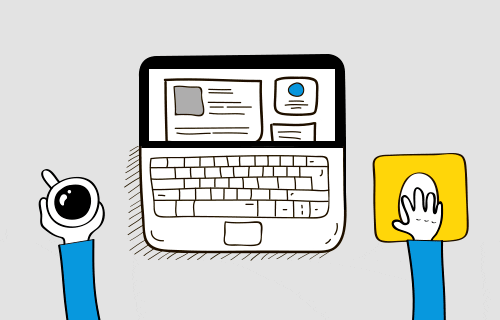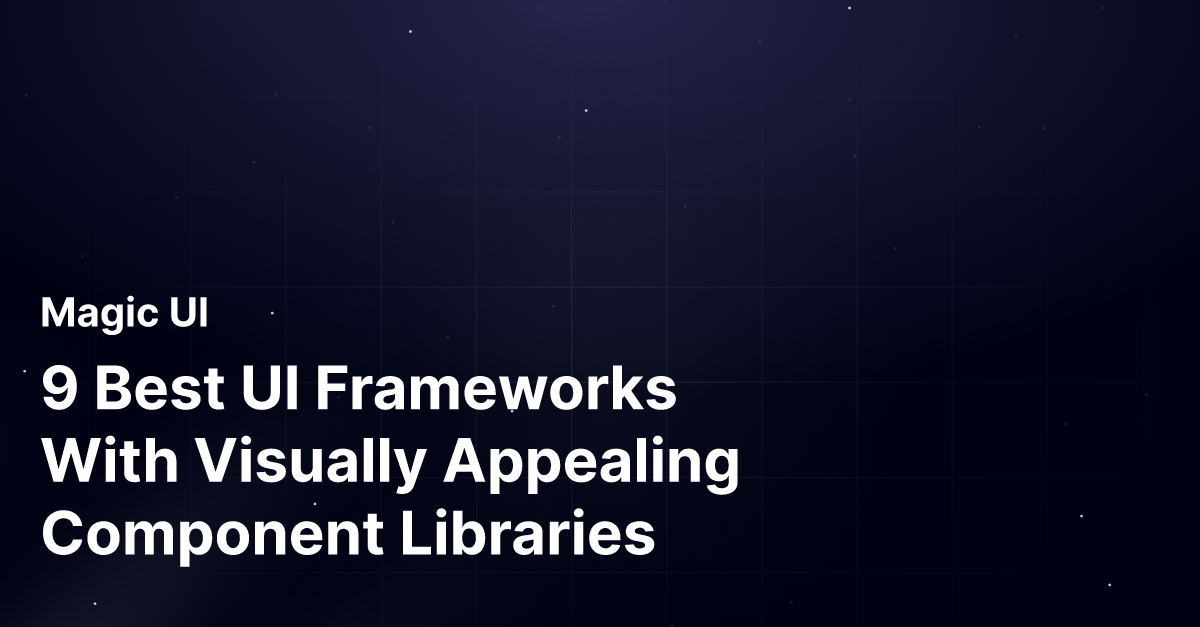Are you tired of spending hours searching for the ideal UI Framework for your next design project, only to feel overwhelmed? UI Frameworks are an essential component of the digital design process, impacting the efficiency and quality of your work. Finding the right one can be a daunting task. In this article, we'll provide valuable insights to help you discover the best UI framework for your design project, empowering you to maximize your creativity, efficiency, and quality without unnecessary challenges.
Discover how Magic UI's user-friendly React component library can help you achieve your design project objectives and seamlessly integrate UI Frameworks into your workflow. With Magic UI, you can streamline your design process, enhance your creativity, and deliver exceptional design projects that stand out. Start benefiting from Magic UI today, and get ready to transform your design experience!
What Are UI Frameworks

Developing a user interface (UI) that is both visually appealing and functional can be a time-consuming task for developers. This is where UI frameworks come in. UI frameworks are pre-made sets of code that provide developers with powerful tools to create user interfaces more efficiently. They are designed to simplify the development process, saving developers time and effort. The UI frameworks emphasize responsiveness, ensuring that the UI adapts to different screen sizes and devices. They also prioritize the user experience, with user-friendly interactions and intuitive navigation at the forefront.
UI frameworks are handy tools for developers. They help eliminate redundant coding and provide consistent styling for UI components. With a UI framework, developers can focus more on user interaction and functionality, speeding up the overall UI development process.
Related Reading
- React Frameworks
- What Are UI Components
- What Is A Component Library
- React Libraries
- React CSS Framework
- React Design Patterns
- Component Libraries
- React Best Practices
Why Use UI Frameworks?

Benefits of Using UI Frameworks
1. Faster development
Using UI frameworks can speed up the front-end development process because developers can access pre-written code libraries and ready-to-use, tested components. This means they don’t have to write code for every component from scratch, saving valuable time and effort.
2. Stunning and consistent UI design
The best frameworks provide professionally styled UI components, such as buttons, menus, carousels, and sliders, which help build aesthetically pleasing UIs. A UI framework ensures a consistent UI design throughout the application, creating a cohesive user experience.
3. Less maintenance
By leveraging a UI framework, developers write less code, which means less maintenance. This reduced codebase simplifies debugging and updating the application, making ongoing maintenance easier and more efficient.
4. Responsive UI design
UI frameworks like Ext JS offer pre-built responsive UI elements that enhance the user experience. This feature ensures that UI design components adapt seamlessly to various screen sizes and devices, such as desktops, mobile devices, laptops, and tablets.
5. Cross-browser compatibility
Top UI and JavaScript frameworks are designed to be cross-browser compatible. This means developers can create UI designs and applications that work efficiently across browsers using a single code base. In other words, the UI components provided by these frameworks are tailored to function seamlessly on various browsers.
Building Stunning Interfaces with MagicUI
MagicUI is a free and open-source UI library that we designed specifically for design engineers. It offers a collection of over 20 animated components built with React, TypeScript, Tailwind CSS, and Framer Motion. We provide a range of visually appealing and interactive elements that can be easily integrated into web applications, allowing us to create stunning user interfaces with minimal effort. MagicUI components are highly customizable, enabling seamless adaptation to match our desired branding and design requirements.
With our focus on animation and a design-centric approach, MagicUI aims to bridge the gap between design and development, empowering us to craft captivating digital experiences. Along with our free component library, with MagicUI Pro, you can save thousands of hours and create a beautiful landing page, and convert your visitors into customers with our website templates.
Use our React component library for free today.
Challenges And Limitations Of UI Frameworks

1. Performance Considerations in Complex Applications
Although UI frameworks offer many advantages, some pre-built templates, components, and libraries might not cater well to complex applications with specific requirements. In such cases, we may need more flexibility and customization beyond what the UI framework provides. This can lead to additional coding and slow down the development process, affecting the overall performance of the UI framework.
2. Performance Overheads
Some UI frameworks have rich and extensive features, including multiple pre-built components and styles. These features offer benefits, but they can also result in larger file sizes. This, in turn, leads to longer loading times and reduced performance, especially in resource-intensive projects.
3. Potential Compatibility Issues with Other Libraries or Frameworks
It is essential to manage dependencies carefully and conduct thorough testing. This will ensure the UI framework behaves consistently across different platforms and devices.
4. Versioning and Maintenance
Regular updates and fixes for UI frameworks bring improvements and new features.They can also introduce incompatibilities that require careful migration and testing.
5. Vendor Lock-In
Choosing a particular UI framework may tie us to a specific vendor, making it challenging and expensive to switch to a different framework later on. It’s essential to consider more flexible and cost-effective options.
While these challenges and limitations exist when using UI frameworks, it’s crucial to remember that their benefits far outweigh the drawbacks. The efficiency and productivity gains from using UI frameworks make them valuable for web development.
Related Reading
- Best React Native UI Library
- React Component Best Practices
- Tailwind Vs Bootstrap
- Material UI Alternatives
- Best React Component Library
- React Tips
- Create React Component Library
- Cool React Components
- Component Library Examples
- Bootstrap Vs React
- React Native Libraries
- Best React UI Framework
- NextJS
- Next.JS
- Next JS
- React Bootstrap
- MUI Table
- MUI Card
- MUI Box
- What Is NextJS
9 Most Popular UI Frameworks For Designers

1. Magic UI
MagicUI is a free and open-source UI library that we designed specifically for design engineers. It offers a collection of over 20 animated components built with React, TypeScript, Tailwind CSS, and Framer Motion. We provide a range of visually appealing and interactive elements that can be easily integrated into web applications, allowing us to create stunning user interfaces with minimal effort. MagicUI components are highly customizable, enabling seamless adaptation to match our desired branding and design requirements.
With our focus on animation and a design-centric approach, MagicUI aims to bridge the gap between design and development, empowering us to craft captivating digital experiences. Along with our free component library, with MagicUI Pro, you can save thousands of hours and create a beautiful landing page, and convert your visitors into customers with our website templates.
Use our React component library for free today at MagicUI.
When to Use Magic UI
Magic UI is ideal for creating captivating user interfaces with minimal effort, bridging the gap between design and development. It's perfect for design engineers looking to craft visually appealing digital experiences.
2. React JS
React is a prevalent JavaScript framework built by Facebook for developing beautiful and functional UIs. It provides pre-built JavaScript code libraries or snippets called components. These components are the building blocks of a React-based app. These are reusable components, meaning you can use them across projects. This means you don’t have to write code for common UI elements for different projects repeatedly. In React framework, you can create any UI element, such as buttons and menus, as custom React components.
When to Use React
React.js excels at constructing user interfaces, particularly within single-page applications. Its robustness shines when creating interactive interfaces, minimizing development timelines through component reuse.
3. Bootstrap
Bootstrap is a widely adopted CSS framework that provides a set of predefined UI components and styles for building responsive web applications. It is easy to use with simple and consistent components. Bootstrap also has a large community and extensive documentation.
When to use Bootstrap
Bootstrap is ideal for developers who need a straightforward solution with minimal customization.
4. Angular
Built by Google, Angular is used by thousands of web developers to build single-page applications. It is a TypeScript-based framework that utilizes component-based architecture. Like React, once you build an interface or UI component in Angular, you can reuse it in various projects. Top Angular component libraries include Onsen UI, Angular Material, and Ignite UI.
When to Use Angular
5. Semantic UI
Semantic UI is a UI framework that focuses on the semantics of HTML. It provides a simple and intuitive way to create responsive websites. Semantic UI uses human-friendly HTML, which makes it easy for developers to understand and use. It also comes with a wide range of pre-built components that can be used to create custom designs.
Despite its status as a newcomer, Semantic-UI has rapidly ascended to prominence within the framework landscape. Distinguished by its intuitive user interface and simplified functionality, it leverages natural language constructs to render code self-explanatory.
When to use Semantic-UI
Semantic-UI excels in scenarios necessitating a lightweight and sleek user interface design, catering to an excellent user experience.
6. Sencha Ext JS
The amalgamation of Sencha Ext JS and Sencha Touch has resulted in a robust JavaScript framework primed to create cross-platform mobile applications. Esteemed for its high-performance UI components, including pivot grids, trees, lists, forms, HTML5 calendars, and D3 adapters, Sencha Ext JS empowers developers to attain optimal outcomes.
When to use Sencha Ext JS
Sencha Ext JS serves well in scenarios demanding a steep learning curve, despite potential challenges such as bugs and crashes. Although it boasts a substantial fan base, alternatives offering easier learning curves and enhanced security are available.
7. Vue.js
Vue.js is a progressive JavaScript framework known for its simplicity and flexibility. It allows developers to build user interfaces and single-page applications incrementally. Gaining rapid popularity, Vue.JS is celebrated for its simplicity and straightforwardness, effectively mitigating complexities often encountered by Angular developers. With advantages spanning reduced size and a component-based architecture, Vue.JS development also employs a two-way binding mechanism.
When to Use Vue.js
Great for rapid prototyping due to its simplicity and ease of integration.
Ideal for small to medium-sized projects where you need a lightweight framework.
Can be easily integrated into projects using other JavaScript libraries.
8. Svelte
Svelte is a relatively new front-end framework that shifts much of the work to the compile step, resulting in highly optimized and performant JavaScript code. This sets it apart from frameworks like React and Vue, which synchronize code to update the document object model in alignment with the application state.
When to use Svelte
Svelte is most suited for compact app projects managed by smaller teams.Its limited support community cautions against employing it for complex undertakings.
9. Ember.js
Ember.js is an opinionated framework for building ambitious web applications. It provides a solid convention-over-configuration approach, a powerful CLI, and a rich set of out-of-the-box features. Introduced in 2011, Ember.js employs a component-based architecture and employs two-way data binding akin to Angular. It proficiently handles the demands posed by contemporary technologies, making it an ideal choice for complex web and mobile applications.
When to Use Ember.js
Ideal for projects that benefit from strong conventions and best practices.
Best for complex web applications with multiple dynamic features and interactions.
Factors To Consider When Choosing A UI Framework
1. Project Requirements
When choosing a UI framework, it is critical to consider your project requirements. These requirements could vary from the complexity of the UI design to the project's scalability. An enterprise solution with a complex UI and countless elements will necessitate a UI framework like Ext JS specifically designed for enterprise-grade app development.
2. Performance and Loading Times
Studies have repeatedly shown that long loading times can discourage users from engaging with an app or website. Therefore, it is vital to evaluate the performance of a UI framework. Assess whether the UI components, such as data grids, load quickly, are responsive, and are cross-browser compatible.
3. Design Consistency
Consistency in UI design is crucial for front-end developers and organizations. A uniform design ensures that all UI elements are consistent across a web app or site. A good UI framework offers UI elements created using the best design principles, allowing you to produce a uniform UI and deliver a predictable user experience.
4. Learning Curve and Documentation
Today's fast-paced software development landscape requires developers and organizations to focus on delivering high-performance apps quickly. Opt for a UI framework that is easy to learn, use, and integrate to save time and effort. Detailed documentation and additional learning resources facilitate learning about the framework's features and implementation, making integration easier.
5. Integration with Existing Projects
If you plan to incorporate a UI framework into an existing project to enhance its UI design, assess its ability to integrate with your project. Analyze your app's architectural design pattern and determine whether the framework supports it.
6. Customizability and Flexibility
While top UI frameworks offer beautifully designed and responsive UI components, customization may be necessary to meet project requirements. Select a framework that supports customization for this purpose.
7. Security Considerations
Security is a significant concern, particularly with open-source frameworks. Third-party developers may provide untested components, potentially laden with malware. Common security vulnerabilities include Cross-Site Scripting (XSS), Distributed Denial of Service (DDoS), and SQL Injection. Always evaluate a framework's security and the security features it offers to mitigate risks.
8. Performance Testing and Optimization
A high-quality framework should function seamlessly across various web apps and efficiently handle data. For example, top frameworks like Ext JS offer a robust JS grid capable of processing large datasets without compromising app performance, enhancing user experience.
The Future Of User Interfaces

Advancements in technology are continuously shaping the future of user interfaces. Modern UI Frameworks will continue evolving to become even more versatile. As the digital landscape expands to encompass a wider array of devices, including smartwatches, IoT devices, and even smart home appliances, UI Frameworks must be adaptive and responsive to this diverse ecosystem.
Emphasizing Accessibility and Inclusivity in UI Frameworks
Modern UI Frameworks will also place a significant emphasis on accessibility and inclusivity. Ensuring that digital experiences are available to all users is critical in today's society. In the future, I foresee UI Frameworks becoming more inclusive, accommodating users with disabilities and diverse needs.
Emphasizing Accessibility and Inclusivity in UI Frameworks
Beyond traditional screen-based interfaces, the future will likely introduce new interaction methods such as voice and gesture-based interfaces. As virtual assistants and smart speakers become more prevalent, UI Frameworks must support voice commands and gestures to provide a seamless user experience.
Enabling Practical Augmented and Virtual Reality Experiences
Augmented and virtual reality are also on the horizon, potentially revolutionizing how users interact with digital content. Modern UI Frameworks will be crucial in making AR and VR interfaces practical and user-friendly. By enabling developers to create immersive and interactive experiences, UI Frameworks will make it easier for users to adopt these emerging technologies.
Integrating Artificial Intelligence for Sophisticated Interactions
Artificial intelligence (AI) is another area that will impact the future of UI Frameworks. As AI-driven interactions become more sophisticated, UI Frameworks must support complex interactions between users and intelligent systems. Conversational interfaces, predictive recommendations, and personalized experiences are just a few examples of how AI will shape the future of UI design.
The Versatile and Inclusive Future of UI Frameworks
The future holds exciting possibilities for UI Frameworks. By focusing on versatility, accessibility, and inclusivity, UI Frameworks will pave the way for innovative user experiences across various devices and interfaces. Voice and gesture-based interactions, augmented and virtual reality, and AI-driven experiences are all on the horizon, and UI Frameworks will play a critical role in making these futuristic interactions practical and user-friendly.
Related Reading
- Chakra UI Vs Material UI
- React Animation Libraries
- Ant Design Vs Material UI
- Mantine Vs Chakra
- Free React Components
- Semantic UI Vs Material UI
- React UX
- Material UI Vs Joy UI
- Ant Design Alternatives
- Material UI React
- MUI React
Check Out Our React Component Library for Design Engineers
MagicUI is a revolutionary UI framework designed for design engineers who want visually striking web applications. The framework offers over 20 animated components crafted with React, TypeScript, Tailwind CSS, and Framer Motion. With MagicUI, creating visually appealing and interactive elements has never been easier. This UI framework allows you to effortlessly integrate captivating components into your web applications, enabling the creation of stunning user interfaces with minimal effort.
Highly Customizable Components for Maximum Flexibility
One of MagicUI's key features is its highly customizable components, which facilitate seamless adaptation to match your desired branding and design requirements. With MagicUI, you can easily tweak and fine-tune each component to align with your design preferences, ensuring a consistent and polished look across your entire web application. Whether you're looking to revamp your existing UI or create a new one from scratch, MagicUI's customization options allow you to create the perfect user interface for your project.
Bridging the Gap Between Design and Development
MagicUI takes a design-centric approach, focusing on animation and aesthetics to deliver captivating digital experiences. By incorporating MagicUI into your projects, you can bridge the gap between design and development, allowing designers and developers to collaborate seamlessly. With MagicUI, you can easily translate your design visions into interactive web components, bringing your ideas to life with stunning visual effects and animations. This design-first approach empowers you to create engaging user interfaces that captivate your audience from the first interaction.
MagicUI Pro: Elevating Your Web Design Projects
MagicUI also offers MagicUI Pro, a premium offering that provides even more value for your web design projects. With MagicUI Pro, you can save thousands of hours and create beautiful landing pages that convert visitors into customers. MagicUI Pro includes a range of website templates designed to maximize user engagement and drive conversions. Whether you're building a portfolio, a business website, or an e-commerce platform, MagicUI Pro empowers you to create stunning web experiences that leave a lasting impression on your audience.
Unlock the Power of MagicUI Today
Ready to take your web design projects to the next level? Start using the MagicUI React component library for free today and experience the power of MagicUI for yourself. With MagicUI, you can effortlessly create captivating user interfaces that stand out from the crowd and delight your users.
Get started with MagicUI and unlock the full potential of your web design projects.
